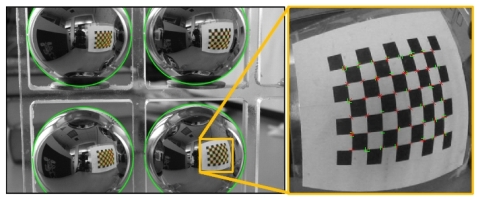TR2013-041
Single Image Calibration of Multi-Axial Imaging Systems
-
- , "Single Image Calibration of Multi-Axial Imaging Systems", IEEE Conference on Computer Vision and Pattern Recognition (CVPR), DOI: 10.1109/CVPR.2013.184, June 2013, pp. 1399-1406.BibTeX TR2013-041 PDF
- @inproceedings{Agrawal2013jun1,
- author = {Agrawal, A. and Ramalingam, S.},
- title = {{Single Image Calibration of Multi-Axial Imaging Systems}},
- booktitle = {IEEE Conference on Computer Vision and Pattern Recognition (CVPR)},
- year = 2013,
- pages = {1399--1406},
- month = jun,
- doi = {10.1109/CVPR.2013.184},
- issn = {1063-6919},
- url = {https://www.merl.com/publications/TR2013-041}
- }
- , "Single Image Calibration of Multi-Axial Imaging Systems", IEEE Conference on Computer Vision and Pattern Recognition (CVPR), DOI: 10.1109/CVPR.2013.184, June 2013, pp. 1399-1406.
-
Research Area:

Abstract:
Imaging systems consisting of a camera looking at multiple spherical mirrors (reflection) or multiple refractive spheres (refraction) have been used for wide-angle imaging applications. We describe such setups as multi-axial imaging systems, since a single sphere results in an axial system. Assuming an internally calibrated camera, calibration of such multi-axial systems involves estimating the sphere radii and locations in the camera coordinate system. However, previous calibration approaches require manual intervention or constrained setups. We present a fully automatic approach using a single photo of a 2D calibration grid. The pose of the calibration grid is assumed to be unknown and is also recovered. Our approach can handle unconstrained setups, where the mirrors/refractive balls can be arranged in any fashion, not necessarily on a grid. The axial nature of rays allows us to compute the axis of each sphere separately. We then show that by choosing rays from two or more spheres, the unknown pose of the calibration grid can be obtained linearly and independently of sphere radii and locations. Knowing the pose, we derive analytical solutions for obtaining the sphere radius and location. This leads to an interesting result that 6-DOF pose estimation of a multi-axial camera can be done without the knowledge of full calibration. Simulations and real experiments demonstrate the applicability of our algorithm.